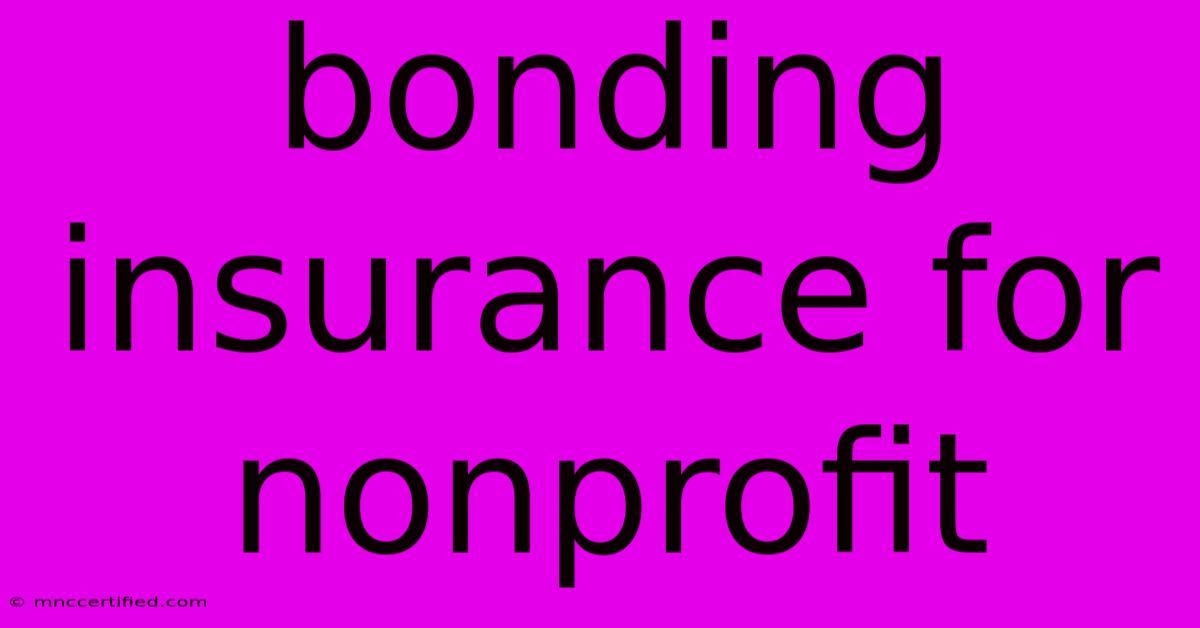Bonding Insurance For Nonprofit

Table of Contents
Bonding Insurance for Nonprofits: A Comprehensive Guide
Nonprofit organizations, while dedicated to noble causes, still face financial risks. Mismanagement, employee dishonesty, or even simple errors can lead to significant financial losses. This is where surety bonds, often called bonding insurance, become crucial. This comprehensive guide explores the vital role of bonding insurance for nonprofits, explaining what it is, why you need it, and how to choose the right coverage.
What is Bonding Insurance for Nonprofits?
Bonding insurance, in the context of nonprofits, is a type of fidelity bond that protects your organization from financial losses caused by the dishonest acts of your employees or volunteers. Unlike liability insurance, which covers accidents or injuries, a surety bond safeguards against intentional wrongdoing. Essentially, a bonding company guarantees that your organization will be compensated for financial losses resulting from embezzlement, theft, forgery, or other fraudulent activities.
Think of it as a financial safety net, providing peace of mind and protecting your valuable resources. This is particularly important for nonprofits who often handle significant donations and operate on tight budgets. A single instance of fraud could severely impact operations and undermine public trust.
Key Differences from Other Insurance
It's crucial to understand the difference between bonding insurance and other types of insurance, like general liability or directors and officers (D&O) liability insurance. While all are important for comprehensive risk management, they cover distinct aspects:
- General Liability Insurance: Covers bodily injury or property damage caused by your organization's activities.
- Directors and Officers (D&O) Liability Insurance: Protects directors and officers from personal liability for wrongful acts in their capacity as leaders of the organization.
- Bonding Insurance (Surety Bond): Protects against financial losses caused by the dishonesty of employees or volunteers.
Why Your Nonprofit Needs Bonding Insurance
The need for bonding insurance for nonprofits stems from the inherent risks associated with handling finances and managing personnel. Here are key reasons why it's essential:
- Protecting Financial Resources: Donated funds, grants, and other assets are safeguarded against employee theft or fraud.
- Maintaining Public Trust: Demonstrating financial responsibility and transparency builds confidence among donors and the community.
- Meeting Grant Requirements: Many grant-making organizations require nonprofits to have bonding insurance as a condition of funding.
- Preventing Financial Ruin: A single act of dishonesty could cripple a small nonprofit, and bonding insurance helps mitigate this risk.
- Compliance and Legal Protection: In some cases, bonding insurance is a legal requirement, ensuring adherence to regulations.
Types of Surety Bonds for Nonprofits
Several types of surety bonds cater to different needs within a nonprofit. The specific bond required will depend on your organization's size, activities, and risk profile. Common types include:
- Employee Dishonesty Bond: This covers losses due to theft, embezzlement, or other dishonest acts by employees.
- Crime Bond: A broader coverage that extends beyond employee dishonesty to include other crimes, such as forgery or theft by outside parties.
How to Choose the Right Bonding Insurance
Selecting the appropriate bonding insurance requires careful consideration of your nonprofit's unique circumstances. Here's a step-by-step guide:
- Assess Your Risk: Identify potential vulnerabilities within your organization, considering the number of employees, financial volume, and internal controls.
- Determine Coverage Needs: Calculate the appropriate bond amount, ensuring sufficient coverage to mitigate potential losses.
- Compare Quotes: Obtain quotes from multiple bonding companies to compare prices and coverage options. Don't solely focus on price; consider the reputation and financial stability of the insurer.
- Review Policy Details: Carefully review the policy terms and conditions, paying attention to exclusions and limitations.
- Seek Professional Advice: Consult with an insurance broker specializing in nonprofit organizations to obtain personalized recommendations.
Off-Page SEO Considerations
To boost the ranking of this article, consider the following off-page SEO strategies:
- Guest Blogging: Write guest posts on relevant websites (e.g., blogs for nonprofit professionals, financial websites) linking back to this article.
- Social Media Promotion: Share the article on relevant social media platforms, using relevant hashtags and engaging in conversations.
- Backlink Building: Seek backlinks from reputable sources within the nonprofit and insurance sectors.
- Directory Submissions: Submit your article to relevant online directories and business listings.
By understanding the importance and nuances of bonding insurance, nonprofits can significantly strengthen their financial resilience and maintain the trust of their stakeholders. This comprehensive guide provides a solid foundation for making informed decisions and securing the necessary protection. Remember to consult with a qualified insurance professional for personalized advice.

Thank you for visiting our website wich cover about Bonding Insurance For Nonprofit. We hope the information provided has been useful to you. Feel free to contact us if you have any questions or need further assistance. See you next time and dont miss to bookmark.
Featured Posts
-
Mc Gregor 2018 Assault Jury Verdict
Nov 23, 2024
-
Security Alert Us Embassy London Package
Nov 23, 2024
-
F1 Las Vegas Grand Prix 2024 Live
Nov 23, 2024
-
First Bond Movie Crossword Clue
Nov 23, 2024
-
Who Is Pam Bondi Trumps Pick
Nov 23, 2024